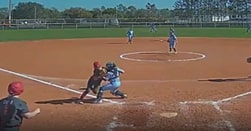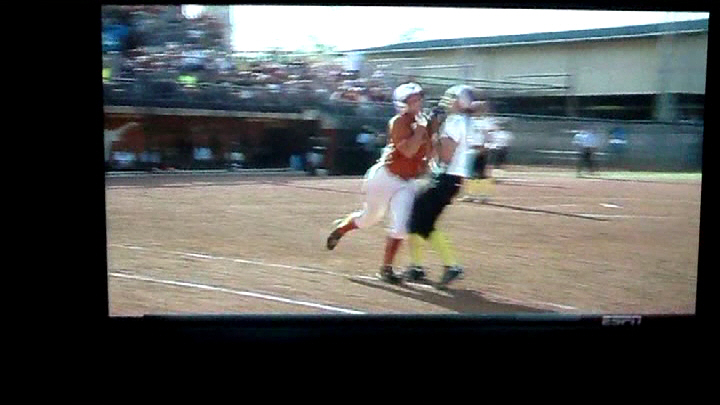Be ready to make this call
The NCAA has added to the rule book additional wording and emphasis on collisions with the intent to encourage players to avoid them whenever possible. This puts additional pressure on umpires, as we now need to judge whether a collision was avoidable, intentional, malicious, obstruction, interference, or some combination of these. Collisions can happen just about anywhere on the field, but the most common collisions umpire have to adjudicate take place between 1B and 2B, 2B and 3B, and at the plate, and increasingly around 1B. We will begin with some tips to help properly apply the rules surrounding collisions.
Pre-pitch the situation. You need to know the fielders set-and-move as the pitcher begins to pitch and where the runners and force plays are. Are fielders starting or moving into the probable path runners will take to the next base?


Considerations
Collisions happen quickly, but we often have time to see them develop before they happen. We can prioritize our judgments and give ourselves the best possible chance to rule on the many elements of a collision play correctly. Here are some things to consider:
• Was the runner going directly to the base, going away from the base, or towards a fielder?
• Was the fielder moving to field a batted ball, moving to catch or retrieve a thrown ball, or moving to a cutoff or backup position?
Different answers to these questions will help determine if a collision is obstruction or interference, or in the rare occasion, incidental contact and “part of the game.”
Breaking it down step-by-step
Collisions usually have a very static sequence of events for umpires to see and decide. Collisions at the plate are especially important to observe and rule correctly, as they make a difference between a run scoring or an out. They can be the most challenging for umpires to officiate. Below are the steps which often happen chronologically on a play with a collision. The calling umpire must be able to take these one at a time to make the right call. Use the same process for collision at the bases.
• The catcher sets up for the potential play
• The throw home is released
• The catcher reads the throw and adjusts, if necessary
• The runner adjusts to the movements by the catcher
• The ball and runner arrive relatively close together and a collision occurs
This relatively static sequence of events allows the umpire to observe the play as it unfolds and make sequential judgments at each decision point of the play.
• Did the catcher set up in a place where she is already obstructing the plate?
• Is the throw apparently off target moving the catcher into the runner’s path without the ball?
• How many running steps did the runner have prior to the collision to adjust?
• Did the runner go into the collision head or shoulder first?
• Did the runner try to avoid the collision?
The answers to these questions should, at least in part, help the umpire decide on the play involved obstruction or not. They will help to decide whether the collision was malicious contact or not. And a structured approach to seeing and judging the key elements of a collision play early frees the umpire at the end of the sequence to focus and accurately judge whether the runner was safe or out.
Collision after obstruction
Because the very act of obstruction puts the fielder in the path of the runner, collisions can often occur during this action. The article in the Rule Corner/Defense section, Obstruction rules, discusses this.
Here are four case plays which are listed in the NCAA Softball 2020 and 2021 Case Book.
Play 1: The right-handed batter who lays down a bunt in front of home plate is on a collision course with the catcher if she runs in direct line to 1b. Each player at this point is acting appropriately, the batter taking a path in a direct line to 1b, and the catcher coming out from behind home plate to field the ball. Ruling: 1) If the batter-runner alters direction in any way and draws contact in an attempt to receive and obstruction call – interference. 2) If the catcher alters her attempt to field the ball in any way so as to draw an interference ball – obstruction. 3) If the catcher cannot actually make an out on the play – no call.
Play 2: The batter-runner collides with the first baseman who is attempting to make a play on an errant throw up the line toward home plate. Ruling: The ruling depends on whether F3 has possession of the ball when the collision happens. 1) If F3 steps to catch the errant throw and has possession of the ball in her glove or hand – no obstruction. 2) If F3 steps into the BR’s path to field the errant throw and does not have possession of the ball in her glove or hand – obstruction
Play 3: R2 takes her lead directly toward F6 who is 10-12 feet behind the baseline (as opposed to a leadoff directly toward 3b). The ball is hit directly over 2b so the runner is in the fielder’s direct line to the ball. Must the runner go around F6 to avoid contact? The runner appears to be trying to draw on obstruction call. Ruling: F6 must be given an opportunity to field the ball with consideration for how deep she is playing and the speed and trajectory of the ball. If the runner interferes with her reasonable opportunity to make a play, that’s interference. If she does not have a reasonable opportunity to play the batted ball, but collides with the runner collision likely occurs.
Play 4: Runner at 2b only and batter bunts the ball toward the pitcher. The pitcher tosses the ball to 1b for the force out and then the BR slides feet first into F3 who was stretching for the toss. The runner from 2b now advances to 3b once F3 is taken out by the BR. Ruling: 1) The umpire may declare the BR out and ejected if malicious contact is ruled. 2) if not, the umpire may rule a double play if the timing is such that the retired BR then interfered with F3 attempting a play on another runner. 3) the third option would be the umpire rules only the BR out if the play was close at 1b and the slide was not malicious.
